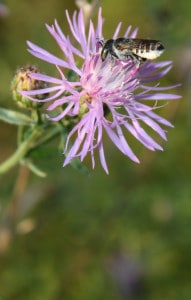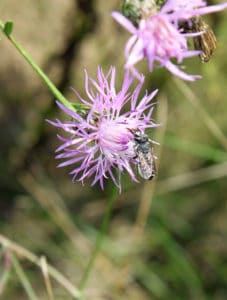
In the last blog, I talked about the invasive plant “Spotted Knapweed.” This plant is unique because it supports several oligolectic bee species, which means that the bees visit (for pollen and nectar) very specific host plant species. Lithurgus chrysurus, or the Mediterranean wood boring bee, is one of them (see previous blog). Another bee that feeds on this Centaurea species is Megachile apicalis, more commonly known as a leaf-cutter bee. This rare non-native species, like the L. chrysurus, is from the Mediterranean region. I have become familiar with both bees from collecting in my hometown in PA for the past 3 summers. To identify this species you must look at it under the stereoscope because it is too hard to see key characteristics with the naked eye.

I have become fascinated with this species along with M. rotundata because they are a possible host for Coelioxys coturnix. C. coturnix is a rare cleptoparasitic bee I found in PA. Cleptoparasites lack pollen collecting structures and do not excavate or build their own nest. Instead, these bees lay their eggs on the host’s provisioned cells. Once the cleptoparasite emerges it will devour the host larvae and consume provisions collected by the host female. I collected a female C. coturnix in 2009 around the time these two bee species were present. I then visited the same area in 2010 and collected a male C. coturnix and both possible host species. I feel this was due to a thriving population of the two host species. I plan to revisit the PA site in 2011 in a few weeks to gather more information on behavior and foraging habits of all three species if present. I fear the prolonged rains in the spring may have an effect on the host plant spotted knapweed.

M. apicalis has also been recorded on the west coast and since relocating here from PA in June, I hope to collect some records of this on the now blooming star thistle. If I do find this species here, I want to observe its behavior and compare it to the eastern populations. Wish me luck, I’ll be sure to report back later if I find anything interesting.